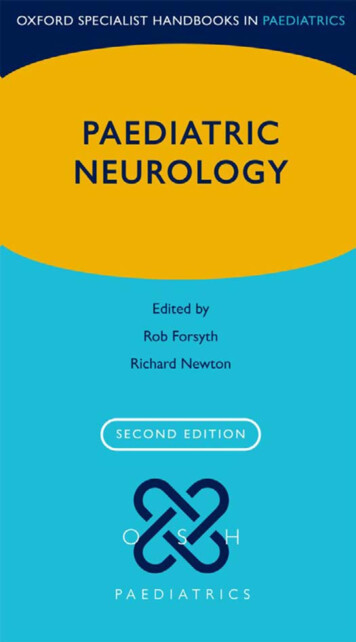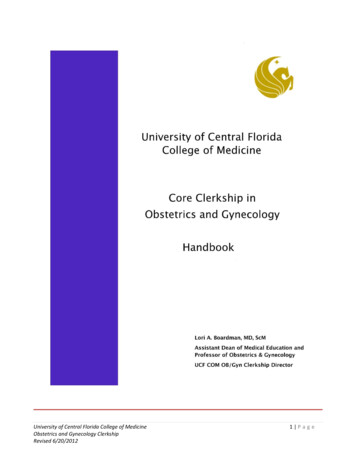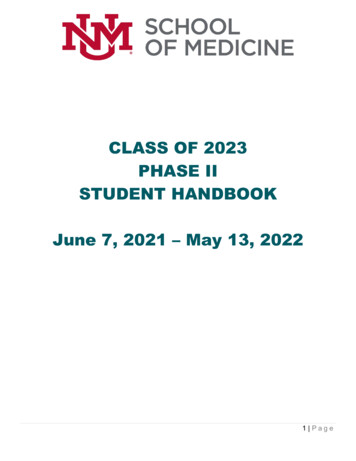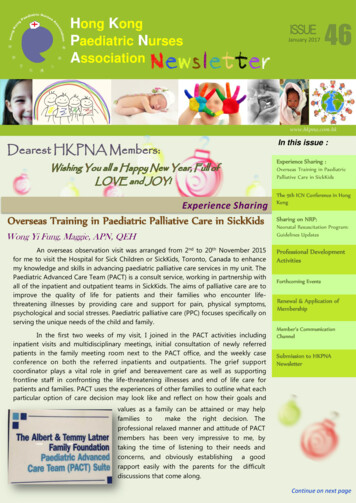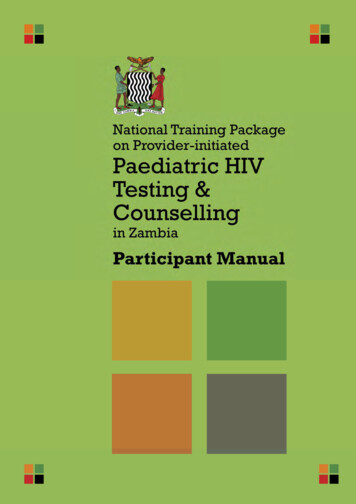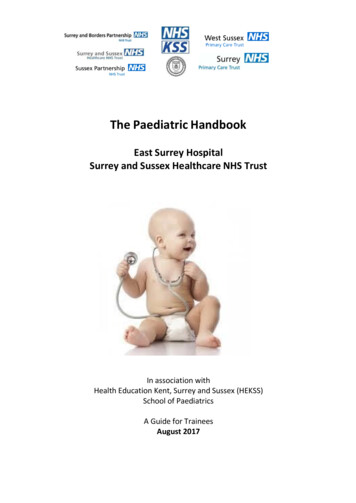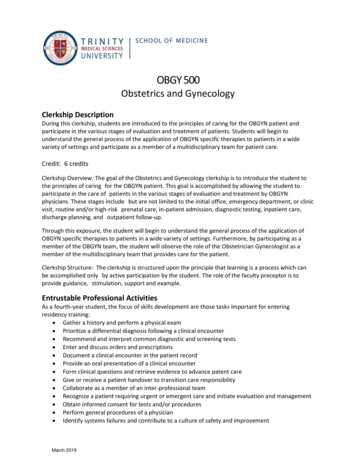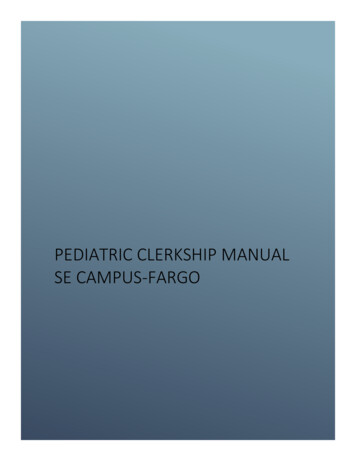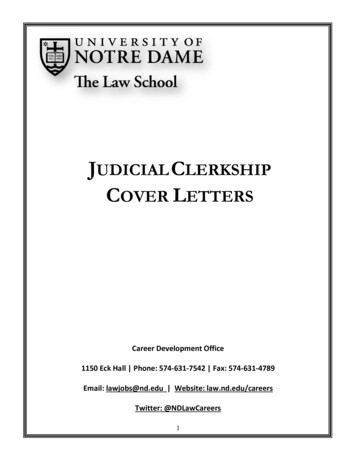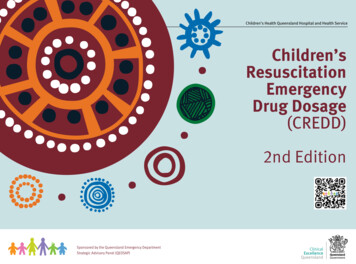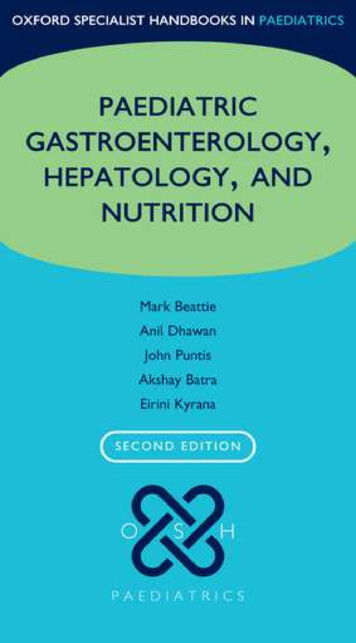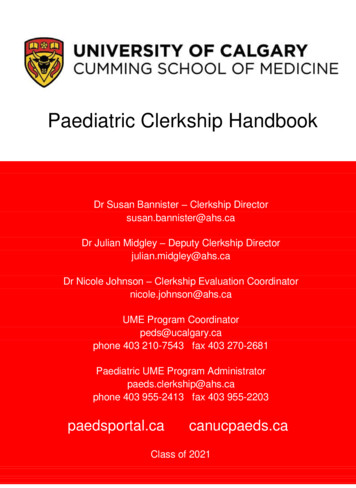
Transcription
Paediatric Clerkship HandbookDr Susan Bannister – Clerkship Directorsusan.bannister@ahs.caDr Julian Midgley – Deputy Clerkship Directorjulian.midgley@ahs.caDr Nicole Johnson – Clerkship Evaluation Coordinatornicole.johnson@ahs.caUME Program Coordinatorpeds@ucalgary.caphone 403 210-7543 fax 403 270-2681Paediatric UME Program Administratorpaeds.clerkship@ahs.caphone 403 955-2413 fax 403 955-2203paedsportal.cacanucpaeds.caClass of 2021
CONTENTSCONTRIBUTORS . 2SNAPPS . 3PAEDIATRIC HISTORY . 4PHYSICAL EXAMINATION . 5ADMISSION CHECKLIST . 6“DAVID” ORDERS . 7PROGRESS NOTES . 7DAILY PATIENT PRESENTATIONS . 8DISCHARGES . 8COMMUNITY FOLLOW-UP . 10GUIDELINES FOR CONTACTING PRIMARY CARE PHYSICIANS . 10APGAR SCORE . 10DRUG CALCULATIONS FOR PAEDIATRICS . 11SIGNS OF DEHYDRATION . 11VITAL SIGNS . 11PAEDIATRIC FLUIDS. 12GROWTH . 13RECOMMENDED ROUTINE IMMUNIZATIONS FOR CHILDREN IN ALBERTA . 15AHS ACUTE CHILDHOOD ASTHMA PATHWAY . 16DEVELOPMENTAL MILESTONES . 17KEY CONDITIONS . 19EMPIRIC AMBULATORY ANTIBIOTIC THERAPY IN COMMON UNCOMPLICATEDCHILDHOOD INFECTIONS. 21COMMON ANTI-INFECTIVE MEDICATIONS IN COMMUNITY PEDIATRICS . 23INITIAL EMPIRIC ANTIBIOTIC THERAPY IN HOSPITALIZED CHILDREN (2013) . 25ANTI-INFECTIVE DOSING CHART . 28PAEDIATRIC LINGO . 29U of C PAEDIATRIC CLERKSHIP CLINICAL PRESENTATIONS. 30CONTRIBUTORSSusan Bannister, Jenn Brenner, David Keegan, Julian Midgley, Preet Sandhu,Michelle Venantius and Lori WalkerEDITORSClass of 2018 edition: Susan Bannister, Julian Midgley and Nicole JohnsonDISCLAIMERThis Handbook has been designed to facilitate your learning and patient care during yourpaediatric clerkship rotation. We hope it will assist you a great deal! While every effort has beenmade to ensure the enclosed material is correct, it is possible that errors may be present.Individuals making clinical decisions should ensure that their care is consistent with up-to-dateguidelines and recommendations, and should review patient management decisions with moresenior clinicians, when appropriate.If you have suggestions on how to improve this handbook for future students, please contactJulian Midgley at julian.midgley@ahs.ca10th March 2017 v1.12
WELCOME TO PAEDIATRICSHave fun learning in a paediatric environment!HOW A CLERK CAN BECOME MORE SELF-DIRECTEDPresent cases in the SNAPPS format to encourage reflection on the problem and possiblesolutions before quizzing your preceptor.This promotes higher level clinical reasoning skills.SNAPPS is learner-driven.SNAPPS S - summarise the caseN - narrow the differentialA - analyse the differentialP - probe the preceptorP - plan managementS - select an issue for self directed learningSummarise the history and findingsPresent only the pertinent facts (the preceptor can readily elicit further details)Try and use only 50% of your time (less than 3 minutes)Some of the background can be discussed with the analysis of the differential diagnosesNarrow the differential diagnosisOffer no more than 3 possible diagnosesFocus on the most likely possibilities rather than on “zebras”Analyse the differentialReview the pros and cons for each diagnosisJustify the relevant diagnostic possibilitiesDemonstrate your analytic clinical skills (verbalise your thinking process)Probe the preceptor (Uncertainties, Difficulties or Alternative Approaches)Not as painful as it sounds!Clarify any difficult or confusing issues/knowledge deficits with your preceptorPlan managementEither a brief management plan or suggest specific interventionsRequires an integrated clinical approachExpect the preceptor to be a rich resource of knowledge and experienceSelect an issue for self-directed learningReflecting on the case may reveal gaps in your knowledge baseMake a note about focused, patient-based questions to guide self-study readingWolpaw TM et al, Academic Medicine 78:893 ltext/2003/09000/SNAPPS A Learner centeredModel for Outpatient.10.aspx3
PAEDIATRIC HISTORYDate/TimeID & CC: Age (in years/months or months/weeks if very young) and sex Hometown May include a major underlying diagnosis if there is one (e.g. epilepsy, CP, Trisomy21, multiple developmental problems) One sentence describing the main concern(s) of the patient/family in general termse.g. “Three-month old male ex-prem (corrected age 40w) with CLD presents withcough and increasingly “noisy breathing” over past 12h”History of the Presenting Illness (HPI): Describe each complaint as cited by caretaker/child Give details of onset, provoking/relieving factors, quality/intensity, radiation,associated signs and symptoms and timing, where relevant, for each complaint Describe family management of problem (drugs, other therapies)Review of Systems: Here or at end of history. Use age-appropriate questions to screen all systems.Immunizations: Details, regular versus elective (if none ask why)Medications: Include dose/kg, how given, adherence Include non-prescription meds/vitamins/complementary therapiesAllergies: Drugs, foods, latex and environmental – specify symptoms If anaphylaxis (ask whether carries Epipen)Past Medical History:Perinatal:Pregnancy Bleeding, infections, HTN, GDM, ETOH/smoking/illicit drugs, medicationsDelivery Gestation, uum, birth weightNeonatal courseOther Cried? resuscitation?, APGARS, neonatal problems, early feeds Past illnesses, hospitalizations, surgeries Other clinics/specialists who see family Previous growth problems or other concerns by family doctor/paediatricianDevelopment: Milestones Vision/hearing/ life skills (toileting, feeding), sleep Gross motor/fine motor/social/speech and languageNutrition/Activity: Current feeding pattern including breast/bottle/weaning/feeding habits Sports, activity, TV time4
Family History: Draw a family tree Family structure including who lives at home Parents ages, occupation and health, consanguinity Siblings age, sex and any illness Inherited illness, childhood illness, child deaths, miscarriages/stillbirthsSocial History: Where and with whom does the child live? Who has custody? Who cares for child – daycare, sitter, parents? Smokers who live at home? School — grade and any special assistance? Supports (at home/while in hospital) Financial concerns/support services involved Impact of illness on child/family/siblingsADOLESCENT HISTORY (HEADSSSSS):Routinely ask Home Education, Eating habits Activities Drugs, ETOH, smoking Sex, Sexuality, Safety, Social, Suicide Other: immunization (tetanus, hepatitis B)PHYSICAL EXAMINATIONIn addition to general (adult type) physical examination (depends on patient age):Have toys handy (for distraction/developmental assessment)Observe carefully during historyInspect for dysmorphic featuresBe flexible, sensitive yet confidentPosition and immobilize patient for certain physical examinations (e.g. otoscopy)Measure and interpret height, weight, head circumference (including plotting on growth curveand calculation of BMI)Measure and interpret vital signs (including BP)Palpate for fontanelles and suture linesPerform red reflex and cover-uncover testPerform otoscopyElicit primitive reflexesPerform neonatal/infant hip examinationAssess the lumbosacral spine for abnormalitiesAssess for scoliosisPalpate femoral pulsesExamine external genitaliaAssess for sexual maturity rating (Tanner staging)5
IMPRESSIONA brief summary of your overall assessment including age, gender and most importantfindings on History, Physical Examination and Investigation. Explain how they may relate(max 3 sentences)e.g. Three month old ex-prem with mild CLD (nighttime home O2) presenting with12 hour history of increased cough and poor feeding but no fever, in moderaterespiratory distress responding well to increased O 2 and very frequent suctioning.Bilateral crepitations, congestion and CXR consistent with viral bronchiolitis with noevidence of bacterial pneumonia.PROBLEM LISTA prioritized point form list of active and chronic issues including a differential diagnosisfor active, undiagnosed problems e.g.1. moderate respiratory distress — likely viral bronchiolitis (RSV most likely),no evidence of cardiac signs & symptoms, differential diagnosis also includesbacterial pneumonia (Strep pneumo, E coli, Staph aureus) O2, qhourly suctioning,expect may require 3 - 5 days of hospitalization2. dehydration/nutrition — mild dehydration, poor feeding trial of frequent smallfeeds, if not achieving maintenance, consider nasogastric tube feeds.3. CLD — continue current aldactazide dose but consider increase if not improving4. ex-prem — recheck CBC for anemia since history of anemia as newborn5. vaccinations — missed 2 month immunisations so consider prior to discharge6. development — needs a more thorough assessment of tone once more stable7. continuity — need to contact Dr. X, regular paediatrician in amPLANOutline in detail your plan for each problem on your problem list (e.g. as above).ADMISSION CHECKLIST***All admissions must include all of the following:(check all are done before calling preceptor/senior to review) A thorough paediatric historyA complete physical examA growth chart plotted with current measurements, including BMIA review of relevant investigationsA review of old charts (where applicable)Formulation of a problem list and differential diagnosisA management plan for each problemComplete ordersCompleted notification of admission form for primary care physicianThe admitting clerk/physician is responsible for ensuring that new orders and notes reachthe inpatient units and for drawing them to the attention of the charge nurse forprocessing6
“DAVID” ORDERSIdentification:“Admit to Unit under Team with ” (Dx e.g. bronchiolitis)D – DIET: e.g. DAT (diet as tolerated), infant—breastfeed or formula ad lib,NPO (nothing by mouth), sips DAT, diabetic, clear fluids only, etcA – ACTIVITY: e.g. AAT (activity as tolerated), bed rest, respiratory/enteric isolation,seizure precautions, C-spine precautions, elevate HOB 30 degrees, etcV – VITALS: e.g. routine (q4h on ACH inpatient units), neuro vitals if indicated.Specify daily weights, and accurate ins and outs and BP if this is important.Also can write to be notified in certain situations, e.g. if RR 40, or if BP systolic 90(depends on age and status of child).I – INVESTIGATIONS: labs, imaging, studies, consults, etc– IVs: solution, rate, additives (e.g. D5W 0.45%Saline @75 mL/hr with 20 mmol/L KCl)D – DRUGS: medication, dose, route, frequency, as calculated based on mg/kg(specify this in order) Include meds from home also (in mg, not mL)NB – Please send notification of admission form (complete form must be filled out).PROGRESS NOTESWeekdays: Patient ID (age, sex, problem/diagnosis, significant underlying condition) Major events in past 24h Clinical exam: write full exam 2x/w if stable; other times highlight relevant parts Daily data: weight (include increase/decrease), meds (eg D4/7 cefuroxime), etc Weekly, must calculate and write meds in mg/kg. Ins (mL/kg/day) Outs (mL/kg/h) Investigations from last 24h Impression (of the current/new problems) Problem List/Plans: for each problem describe ongoing therapy or plans.Include fluid/nutrition, discharge planning, on-call plans Changes to condition, test results—add to chart throughout the day Add plans from rounds to your progress/supplemental note Friday notes: write detailed note including specific plans for the weekend.Ensure plans for any anticipated discharge are prepared, paperwork is completed andclearly outlined in notes.Weekends: On known patients, write brief notes highlighting changes On-call: Document every time asked (parent, RN, attending) to reassess/see patientor change treatment.Post Op: All post-op patients must be examined and an update note documented in the chartChronic Patients: Keep an active problem list in your notes Ensure growth chart plotted weekly Medications calculated once per week in mg/kg/day Development Summary x1/month for infants/toddlers Summary dictation monthly or when going off-service Discuss social issues/discharge planning regularly7
DAILY PATIENT PRESENTATIONS Be brief but thorough, prepare for presentations before rounds Start with a brief identification e.g. “This 3 year old boy presented two days ago withcough and fever and is on his second day of treatment with antibiotics forradiographically confirmed pneumonia” State significant occurrences over past 24h e.g. “afebrile now for 24h with RRdecreasing (20s) from admission and starting to drink better. Now off O 2” Pertinent findings on clinical exam: “vitals stable with RR 24 and no signs ofdistress. Still decreased AE on right with faint crepitations but improved AE and clearon the left. Exam otherwise unchanged” Ins and Outs (see Progress Notes above), meds, recent labs, radiographs, wt etc Problem list and plan for each problem:1. Bacterial pneumonia — improving change to po antibiotics today and considerdischarge tomorrow if remains afebrile2. Dehydration-resolving saline lock IV and reassess this afternoon3. Speech delay arrange for hearing test after discharge4. Delayed immunizations will book appt for MMR/varicella next week5. Discharge Planning as above, continue cefprozil to complete 10 day course,follow up with GP next week — will call todayMEDICAL STUDENT TELEPHONE CONSULTATION REQUEST GUIDEThe purpose of this guide is to help you be a more effective telephone communicator toconsultants.1. Identify the consultant (or fellow/resident) on the required service using ROCA.2. Hello, Dr. this is from the (e.g. CTU)I have a patient I'd like to present to you please for a consult.3. (Pause for acknowledgment by consultant)4. is a year/month old who presented complaining of .5. Give relevant history and data.6. I think the most likely diagnosis is .7. This is what we've done for him already .8. I'd like you to evaluate him for (explain your questionclearly).9. We are hoping this consultation can be done (e.g. urgently, nonurgent).10. Thank you!Total phone time should hopefully be less than one minuteDISCHARGES Discharge planning should be discussed regularly on rounds as an “issue” Discharges which may occur over the weekend should be planned well in advance Discharge orders should include:o Follow Up with physicians (specify when and where and with whom)o Planned investigations (specify when and where and complete requisition)o Discharge medications (even if the same as admission)o Specific things to watch for and what to do if they occur**clerks/residents should personally review all the of the discharge plans with the familyprior to their departure and answer any questions8
DISCHARGE CHECKLIST Follow up appointments booked or indicated Follow up investigations indicated/requested Discharge medications indicated Prescriptions Discharge orders (may be conditional or discharge planning ordersincluding medications, follow up, investigations and what to watch for) Handwritten discharge summary completed Discharge summary faxed to next physician Communication with next physician (via faxed discharge summary,phone call /- consult note) IV’s, central lines removed Teaching e.g. Asthma teaching, Epipen teaching Notification to family of potential discharge and discharge time Communication to family about discharge plans including danger signs to watch for Notify charge nurse of potential discharge dateDISCHARGE SUMMARIESA. For uncomplicated short stay patients complete short written discharge sheet.Please print clearly. Note discharge summaries must be signed by your seniorresident or attending physician. Ensure copy is faxed to the office of primary carephysician prior to patient discharge.B. How to dictate: (most discharge summaries at ACH/PLC will be into SCM)Dial: 77778 (outside line 1-855-648-3117) or access number appropriate for siteENTER your Speaker Code followed by #ENTER Facility code (ACH 191, FMC 192, PLC 194)#ENTER Work type D/C SUMMARY CODE 20# (Transfer summary 21#)ENTER Patient's 10 DIGIT MEDICAL REGIONAL HEALTH NUMBER (MRN) # ,Press 2 to begin dictation (if STAT Press 1 after pressing 2). Other buttons 2 to holdand restart, 3 to short rewind, 4 to rewind to beginning, 5 to fastforward, 9 to end)."This is (your name) clinical clerk dictating for (doctor) on(date) from (Alberta Children’s Hospital). Discharge summary onpatient . Patient number DOB: .Please send copies to: family doctor, , Hospital paediatrician (specifyname), the emergency physician who saw the patient, community paediatrician,consultants, your resident .Admission Date:Discharge Date:Most Responsible Diagnosis:Other Diagnoses: (please list as many as possible)Procedures in Hospital (include date, surgeon, investigations):Summary Note:HPI, PMHx, Meds/Allergies, FHx, Social History, Physical Exam at Admission,Investigations at Admission, Course in Hospital and finish with Discharge Plans(condition, follow-up, meds, etc). Obtain confirmation number and document thison patient chart.END OF DICTATION – PRESS 9. WRITE DOWN CONFIRMATION #.9
COMMUNITY FOLLOW-UP Ensuring continuity of care and good follow-up is critical Community paediatricians may be consulted for “concurrent care” for complicated orchronic patients Please notify community paediatricians directly, by phone, of important investigationfindings, diagnoses or deterioration (e.g. transfer to PICU) Before discharge, phone the primary care physician to arrange follow-up Send a short note to their office by fax if immediate follow-up is planned A copy of the discharge summary or a short note should be faxed to primaryphysicians at the time of dischargeGUIDELINES FOR CONTACTING PRIMARY CARE PHYSICIANSTo ensure efficient communication with community paediatricians and family physicians,you should contact them by phone prior to the discharge of their patient. When you call,you should have, at hand, the following information: Patient’s demographic information including most recent weight, height and HC Date of admission and discharge List of diagnoses while in hospital Why and when you would like the patient to see them What follow-up you expect them to do e.g. reassess asthma med doses, follow-upweight weekly etc. Communicate clearly in a consult note and/or phone call. You should be able to give a succinct but thorough summary of how the patientpresented & what was done Most recent or significant investigations (fax most recent labs if pertinent) Discuss any social stressors for the family or involvement of social work or otherservices deemed necessary while in hospital Describe the discharge condition of the patient including any abnormal physicalfindings (e.g. the patient still has scattered wheeze and decreased air entry on right)weight and other growth parameters Be prepared to give exact doses of medications which you are sending the patienthome with and for how long Let them know any other specialists who are involved and other planned follow-up Mention any labs which are outstanding and need to be followed (e.g. VCUG,metabolic studies) Ask for an appointment or ask the unit clerk book a time for the patientAPGAR SCOREAppearancePulse rateGrimaceActivity (Muscle Tone)RespirationScore of 0Blue or pale all overAbsentNo responseNoneAbsentScore of 1Blue extremities 100 / minFeeble cry/grimaceSome flexionSlow & irregularScore of 2Pink all over 100 / minCryFlexed and activeStrong cryThe test is generally done at one and five minutes after birth, and may be repeated later if thescore remains low. Scores 3 and below are generally regarded as critically low, 4 to 6 fairly low,and 7 to 10 generally normal.10
DRUG CALCULATIONS FOR PAEDIATRICSBasic concepts:- most drugs in paediatrics are dosed on body weight, some on body surface area- some neonates' drugs are dosed on birth weight until they surpass their birth weight- references (eg Lexicomp) may list dosages in mg/dose or mg/dayExample:Emily is admitted for query meningitis. She is 4 days old; her birth weight was 3.5 kg.She now weighs 3.2 kg. One of the drugs you decide to treat her with is ampicillin.Lexicomp-on-line entry for ampicillin.Usual dose for neonates:postnatal age 1 wk and 2000 g for meningitis is 150 mg/kg/day, divided q8h.Dose is based on her birth weight of 3.5 kg:150 mg/kg/day x 3.5 kg 525 mg/dayDrug is given q8h (in three divided doses):525 mg/day divided by 3 175 mg/doseOrder is written as:Ampicillin 175 mg IV q8h (150 mg/kg/day)Include the dose you used to calculate the patient's drug in brackets as part of your order.SIGNS OF te10%6%Severe 15% 9%Limp/ColdAppearanceAlertRestlessHeart easedDeep/rapidBPNormalNormal or lowLowSkin TurgorNormalSlow retractionRetraction 2 secsGrossly oistDryVery DryMucous MembranesUrine OutputDecreasedMinimalAnuricSpecific Gravity 1.0201.030 1.030UreaNormalElevatedVery highArterial pH 7.307.10 – 7.30 7.10 2 seconds2 – 3 seconds 3 seconds30 – 50 mL/kg60 – 100 mL/kg90 – 150 mL/kgCapillary RefillFluid deficitVITAL nt30 - 50120 - 160 603-46 mths - 1 yr30 - 40120 - 14070 - 808 - 102 - 4 yrs20 - 30100 - 11080 - 9512 - 165 - 8 yrs14 - 2090 - 10090 - 10018 - 268 - 12 yrs12 - 2080 - 100100 - 11026 - 50 12 yrs12 - 1660 - 90100 - 120 50AgeSystolic BP(mmHg)Weight(kg)For children over 1 year: Systolic blood pressure 2 x age in years 90 (in mmHg)(gives an approximate value for 50th percentile)11
PAEDIATRIC FLUIDS“Maintenance Fluids” (4-2-1 Rule) – this only maintains “usual intake”*Note there are many approaches for calculating fluid requirements in paediatrics,this is one approach. Used to calculate approximate basic fluid requirements in otherwise healthy childrenand infants Need to make adjustments for patients with fever, renal impairment, heart disease,SIADH or uncontrolled losses (e.g. post surgical, vomiting or diarrhea) and neonates Gives per hour fluid requirementGive 4 mL/h for each kg of first 10 kg (or portion thereof)Give 2 mL/h for each kg of second 10 kg (or portion thereof)Give 1 mL/h for each remaining kgExamples: Calculate “Maintenance Fluids” for each of the following:a) 4.2 kg baby 4 x 4.2 16.8 mL/hrb) 11 kg child (4 x 10) (2 x 1) 42 mL/hrc) 36 kg child (4 x 10) (2 x 10) (1 x 16) 76 mL/hrTotal Fluid Intake (TFI) for NeonatesNeonatal Day 160 mL/kg/dayNeonatal Day 280 mL/kg/dayNeonatal Day 3100 mL/kg/dayNeonatal Day 4120 mL/kg/dayNeonatal Day 5150 mL/kg/dayRange for normal neonates 100 - 200 mL/kg/dayMay need to restrict fluids for babies with CHD/AKI (specify maximum TFI in orders)Fluid in (as TFI) calculate as mL/kg/dayUrine Out express calculate as mL/kg/hourChoice of Fluids Use the gut whenever possible (e.g. po or ng) By NG, fluids can be given continuously or bolused IV: As a general rule, it is safe to use D5W-0.45%Saline for most infants & children.For very young babies you may consider D10W-0.45%Saline.There are other exceptions, including those with head injuries or meningitis whenD5W-0.9%Saline is more appropriate For patients with DKA refer to DKA protocol for fluid management 20 mmol/L KCL is often added to IV’s (even TKVO) as long as the patient has normalkidney function & normal serum potassium Bolus using 0.9% Saline or Ringers Lactate only (usually 10 - 20 mL/kg) – no KCL Remember TKVO (5 mL/hr or 10 mL/hr for CVL) can be a lot of fluid for a small childAbove calculations apply for usual fluid requirements, not nutritional requirements.How much should a baby be drinking?AgeNumber of feedingsVolume of each feed(in months)per dayoz0-17 - 102-42-35-84-64-64-65-67-93-56-710 - 123-46-812Volume of each feedmL60 - 120120 - 180150 - 180180 - 210180 - 240
GROWTHWeight- average birth weight is 3.5 kg- expect a 10% weight loss in the first seven days- regain this loss by ten days- weight should double by five months, triple by one year and quadruple by two years- 50th percentile for 12 months is 10 kgQuick way to estimate a child’s weight in kilograms:For 3 - 12 months (age in months 9)/2For 1 - 6 years 2 x age in years 8For 7 - 12 years ((age in years x 7) – 5)/2Length/Height- measure length (supine) 2 years- measure height (standing) 2 years- average length at birth is 50 cm at birth, increases by:25 cm in first year12 cm in second year8 cm in third year4 - 7 cm/year until puberty- 50% adult height by 2.5 yr (newborn 30% adult height)- estimate from 2 to 12 years age in years x 6 77 (in cm)Head Circumference (HC or OFC)Measure head circumference: - all children 2 y- children with developmental or neurological issuesOn average: 35 cm /- 2 cm at birth (term)40 cm /- 2 cm at 3 months45 cm /- 2 cm at 9 months50 cm /- 2 cm at 3 years55 cm /- 2 cm at 9 yearsOr, to estimate head circumference during the first year, the head grows at a rate of:- 2 cm/month for the first three months- 1 cm/month for the next three months- 0.5 cm/month for the last 6 monthsBSA (in m2) BMI weight in kg x height in cm3600(in kg/m2) body weight/height2CHILDHOOD ENERGY REQUIREMENTS AND GROWTH RATESCals/KgProtein (g/day)Growth RatesPreterm – 2 months100 – 120 3.515 – 25 g/kg/day3 months – 1 year95 – 1001.515 – 30 g/day1 to 3 years951.16 – 18 g/day4 to 9 years88 – 1000.95160 – 200 g/month9 to 13 years73 M, 61 F0.9513
NUTRITIONBirth - exclusive breastfeeding or iron-fortified formula up to 6 months- vitamin D 400 IU / day while exclusively breastfeeding- (if breastfeeding is discontinued, switch to iron-fortified formula)* do not microwave milk/formula - it destroys nutrients and can burn the mouth6 months - add iron-fortified cereal (use until at least 18 months)- start with rice cereal- every 3 - 5 days, introduce another single-grain cereal (eg. oatmeal)- use mixed-grain cereals after all single grains introduced- by 8 months, add plain yogurt or fruit to keep baby interested in cereal- add pureed vegetables- start with green or bland foods - every 3 - 5 days, introduce another vegetable7 months - add pureed fruit - if constipated add pureed prunes- give unsweetened fruit only- every 3 - 5 days, introduce another fruit8 months - add meats and alternatives- puree meats initially, offering new one every 3 - 5 days- hard-cooked egg yolk is okay- legumes (kidney beans, chickpeas and lentils) are a good alternative12 months - add cow's milk- homogenized (full-fat) milk until at least 24 months- no more than 24 ounces (720 mL) per day (20 ounces by age 2 years)FORMULAS (0 - 12 months)1. 2000 g Birth Weight:a) Cow’s Milk Based- Similac Special Care 24 (0.81 kcal/mL)- Similac Neosure ( 1250g) (0.74 kcal/mL)- Similac Natural Care (0.79 kcal/mL)- Similac Human Milk Fortifier (3.33 kcal/packet)b) Formula fortifiers:2. 2000 g Birth Weighta) Cow’s Milk Based - made of casein/whey/lactose- Similac Advance (0.68 kcal/mL)- Similac 24 (0.81 kcal/mL)- Similac 27 (0.92 kcal/mL)b) Cow’s Milk Based - made of hydrolyzed whey (GERD and renal problems)- Nestle Good Start (0.67 kcal/mL)3. Soy Based - for lactose intolerance, IgE Cow milk protein allergy, galactosemia,vegetarians- Isomil (0.68 kcal/mL)4. Hydrolyzed Casein Based - for protein and fat malabsorption- Alimentum (0.68 kcal/mL)- Pregestimil (0.69 kcal/mL)5. For Fat Malabsorption- Portagen (0.9 kcal/mL)6. For Renal Failure- Similac PM 60/40 (0.68
This Handbook has been designed to facilitate your learning and patient care during your paediatric clerkship rotation. We hope it will assist you a great deal! While every effort has been made to ensure the enclosed materi
